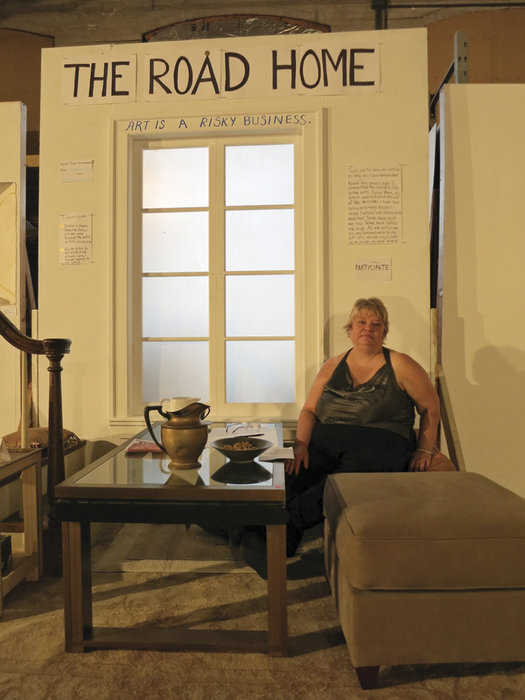About a decade ago, after years of self-doubt and second guessing herself, conceptual artist Trish Szymanski made the decision to completely dedicate herself to her art.
This decision, she said recently, has been rewarding, but it has also come with perils. Anyone who went to the group show hosted by Pro Arts at the Tenmarc Building during the recent Artists’ Studio Tour may have noticed Szymanski’s latest conceptual installation, “The Road Home: Art is a Risky Business.” The piece, which was inspired by Szymanski’s eviction from her McGinley Square apartment in June, features living room furniture and a stairway banister set against a large window.
The scene looks like it could have been ripped from any number of cozy new condos around the city. The set up intentionally recalls what Szymanski has lost, what she hopes to one day regain, and the work for which she has sacrificed everything.
‘[Homelessness] changes a lot of relationships. Some people just fell away.’ – Trish Szymanski
____________
The time being
Like most artists, actors, musicians and others in the creative fields, Szymanski has never experienced the success of fellow conceptual artists Jenny Holzer and Tracey Emin. But she had done enough work locally that she thought she should commit herself fully to her life’s work if she wanted to see a greater payoff from it.
For the 2006 Artists’ Studio Tour, she turned her spoken word performance series, “Last Saturday’s News” into an art installation. More recently, in 2009, she collaborated with painter Loura van der Meule on another installation, titled “The Time Being,” which examined Dutch history in Jersey City and that history’s connection to other events from 1209 through 2009.
Over the years, Szymanski, who also sings and acts, has performed off-off Broadway and has been cast in various local plays. She was included in the Jersey City Magazine article, “Fringe Element (2010-2011 Fall/Winter),” which featured some of city’s most creative and outlandish people.
Like many artists, she waited tables and did other part-time gigs to pay the bills. But she landed in landlord-tenant court when the economy softened and she found herself, she said, “underemployed.”
“I was in court twice in the spring. The first time I got through it. The second time I lost and I got evicted,” Szymanski recalled. “I’ve been underemployed for years and it just caught up with me. I didn’t have any resources. I got down to the end of everything.”
Without any place to go or to call home, Szymanski said, “I had to figure out how to reach out to my community with grace. It was really important for me to maintain grace.”
Some doors, she said, were opened to her. Many others were shut.
“You never really know what’s going on in someone’s personal life. Some people could not reconcile what they knew about me [on one hand], and me being at the end of my financial rope [on the other],” said Szymanski. “Some people judged me for not being able to find enough appropriate work. They thought I should do things that I knew I could not. After I was evicted, people who offered me support thought I should act in a certain way in response to their support.”
Proving the adage that real friends are revealed in times of crisis, Szymanski said her eviction and subsequent homelessness, “changed a lot of relationships. Some people just fell away. I lost my primary intimate relationship because of this. A lot of people I was close to I’m not close to now. A lot of people I was close to I’m closer to now.”
The road home
In the middle of this personal crisis, one of the organizers of the 2012 Artists’ Studio Tour approached her and asked her to submit work for a group show that would be taking place at the Tenmarc Building. Believing the tour and the show were too important not to participate in, Szymanski agreed.
Thus, from Oct. 12 to 14 people who went to the Tenmarc Tour stop were treated to Szymanski’s latest installation, “The Road Home: Art is a Risky Business.”
The interactive piece featured Szymanski sitting in the “living room” inviting people to enter and engage in a conversation about art. Each of Szymanski’s “guests” was also invited to select a piece of paper that included a word. That word would then be used as the basis of her conversation with each guest.
About 20 people entered her living room during the Studio Tour.
At present, Szymanski is staying in a room offered to her by a friend. She has been living in the room since the beginning of September in an arrangement she described as “open-ended, but not long-term.”
For money she currently works at a couple of restaurants and assists two small businesses that vend at local farmers markets. Her income, she said, is better than it was at the beginning of the year. Still, she is eligible for social services and may soon try to get certified for Food Stamps.
After the response she received for “The Road Home” during the Studio Tour she said she is now trying to get the installation exhibited again for a longer period of time and might try taking it on the road to art spaces around the country.
“This experience of losing my home, and not really being prepared for it in a practical way, it obviously changed me,” Szymanski said, adding that she has few regrets about how she is living her life. “It’s been a catalyst for a stage of personal evolution.”
E-mail E. Assata Wright at awright@hudsonreporter.com.
